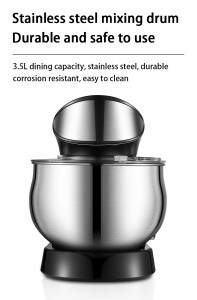In the world of baking, there’s nothing quite as satisfying as the luxurious creaminess of the perfect combination of butter and sugar. While there are a variety of ways to achieve this delicious texture, using a stand mixer is often favored by professional bakers and enthusiastic home cooks alike. In this blog, we explore the art of creaming butter and sugar in a stand mixer, revealing tips, techniques, and precautions to ensure your sweet creations are flawless.
1. Perfect Butter:
First, softened butter must be used, not melted or cold butter. Allow the butter to come to room temperature naturally, or use gentle techniques such as cutting it into small pieces to speed up the softening process. This allows the sugar crystals to effectively incorporate air into the mix, giving your recipes a light and fluffy base.
2. Choose the right sugar:
Granulated white sugar is the most common choice for creaming. Its small crystals help break down the butter, allowing for maximum aeration. However, brown sugar or a combination of the two can add depth and moistness to your final creation. Whatever sugar you choose, make sure it’s fresh and lump-free so that it blends seamlessly.
3. Stand mixer main points:
Investing in a quality stand mixer will significantly enhance your baking experience. Look for models with variable speeds, paddle attachments, and sturdy bowls. Before starting, attach the paddle to the stand mixer and adjust the height, making sure it reaches the bottom of the bowl without touching it.
4. Frosting skills:
Place the softened butter in the bowl of a stand mixer and begin beating the cream on low speed. Gradually add the sugar, while whisking constantly, until the ingredients are fully combined and the mixture has lightened in color and texture. It is important to keep scraping the sides of the bowl with a spatula to ensure an even creaminess.
5. Matters needing attention:
For successful creaming, avoid overmixing, as this can lead to a greasy texture in baked goods. Once the butter and sugar are well combined, proceed directly to the next steps of the recipe to maintain the lightness and fluffiness achieved during the creaming process.
6. Troubleshooting:
If the butter and sugar mixture is grainy, the butter may be too cold. Pause the process to allow the butter to soften further, then continue creaming until the desired texture is achieved. Conversely, if the mixture curdles or separates, the butter is probably too hot. Just let it cool for a few minutes, then keep whisking until the mixture is smooth again.
A stand mixer is an invaluable ally in the quest for baking excellence. Mastering the art of creaming butter and sugar is an essential skill that opens the door to countless sweet creations. Following these techniques and precautions will ensure your creamy mixture is always airy and light, resulting in delicious meals that will leave your loved ones craving for more. So put on your apron and get ready to up your baking game, one batch of fluffy loaves at a time!
Post time: Aug-18-2023

